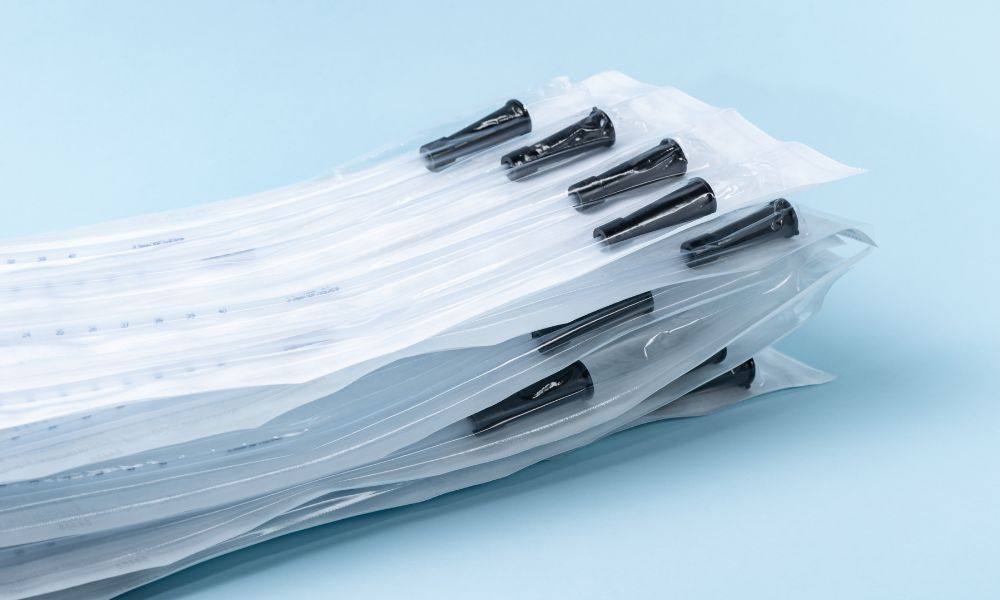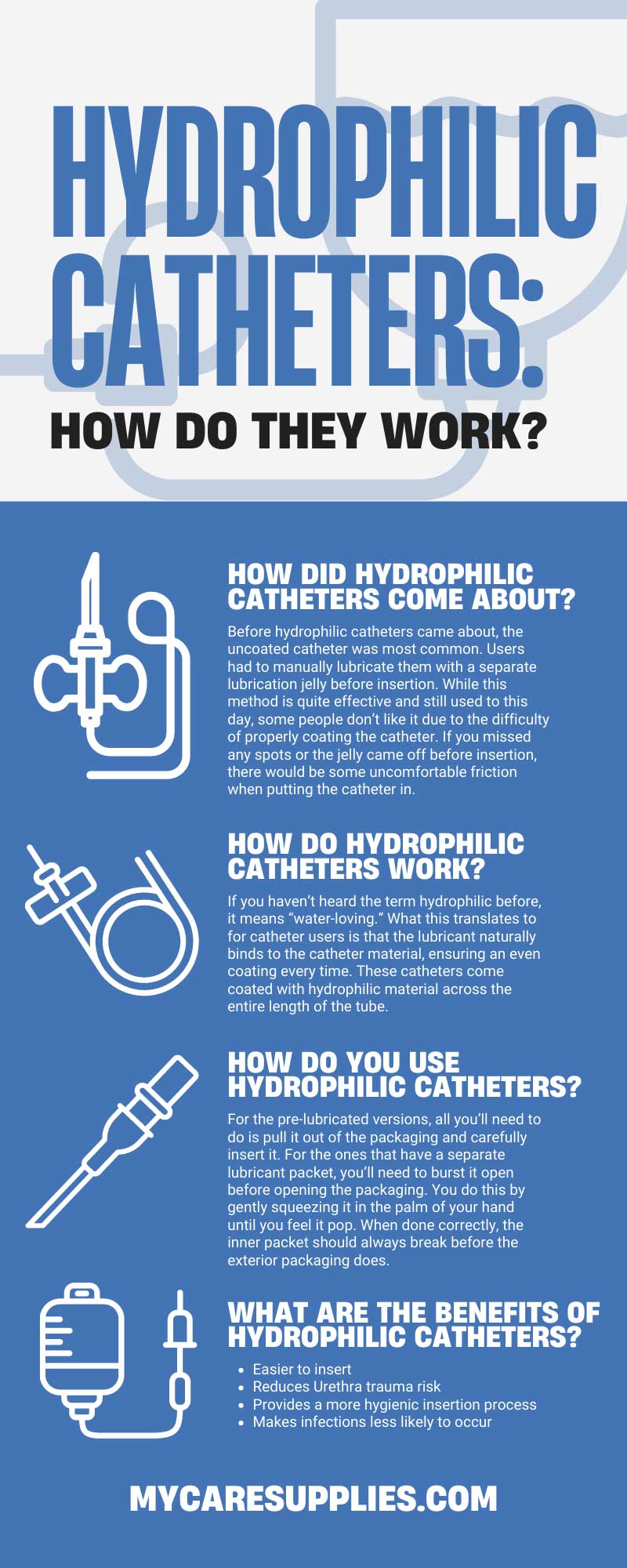Hydrophilic Catheters: How Do They Work?
Posted by Jeanne Lowry on Nov 14th 2022

The first thing people discover when they find out they need to use a catheter is that there are many different types to choose from. Each catheter type also has a wide variety of features that can benefit you in one way or another. When you’re brand new to using these devices, it can be a bit overwhelming.
That’s why we want to go over a specific type of catheter that you should consider trying. They’ve been around for a while but are still a bit of a newcomer, which is why you might not have heard about them. They’re known as hydrophilic catheters. We’ll go over what they are and how they work, so you can make a well-informed decision on whether they’re right for you.
How Did Hydrophilic Catheters Come About?
Before hydrophilic catheters came about, the uncoated catheter was most common. Users had to manually lubricate them with a separate lubrication jelly before insertion. While this method is quite effective and still used to this day, some people don’t like it due to the difficulty of properly coating the catheter. If you missed any spots or the jelly came off before insertion, there would be some uncomfortable friction when putting the catheter in.
Because of this complication, there was a demand among users for an alternative that was more comfortable and consistent. Some manufacturers took this opportunity to develop a new type of catheter to fix this issue. Not long after, hydrophilic options first hit the market.
How Do Hydrophilic Catheters Work?
If you haven’t heard the term hydrophilic before, it means “water-loving.” What this translates to for catheter users is that the lubricant naturally binds to the catheter material, ensuring an even coating every time. These catheters come coated with hydrophilic material across the entire length of the tube.
Some options are pre-lubricated, while others receive their lubrication right before you open the packaging. Regardless of the method, you won’t have to worry about any dry spots on the catheter. Additionally, hydrophilic catheters make insertion a much quicker process since you don’t have to apply the lubricant manually.
How Do You Use Hydrophilic Catheters?
While the process for inserting hydrophilic catheters seems fairly straightforward, there are some specific steps you’ll need to follow depending on the variation you use. Regardless of the type, you should always start by washing your hands thoroughly. Both types give you a handling sleeve that allows you to pick it up without touching the lubricant but keeping your hands as sterile as possible is always a good practice.
For the pre-lubricated versions, all you’ll need to do is pull it out of the packaging and carefully insert it. For the ones that have a separate lubricant packet, you’ll need to burst it open before opening the packaging. You do this by gently squeezing it in the palm of your hand until you feel it pop. When done correctly, the inner packet should always break before the exterior packaging does.
After the packet ruptures, you’ll need to flip the packaging around a few times to ensure that the entire catheter becomes coated in the lubricant. This could take anywhere from 15 to 30 seconds. Once you’ve done that, you can open the packaging and insert the catheter the same way you would the pre-lubricated version.
Even though hydrophilic catheters were made to avoid problems that cause friction upon insertion, there’s still a slight chance it could happen. That means you should always insert your catheter slowly and stop if you feel any pain or resistance. It never hurts to be careful in situations such as this. Also, upon insertion, you can still deal with small urine leaks. This situation always has a chance of occurring during a catheter insertion, regardless of the type you use.
What Are the Benefits of Hydrophilic Catheters?
Now that we’ve fully covered what hydrophilic catheters are and how they work, we want to cover the benefits of this type of device. While some of the benefits have been made clear already, we still want to consolidate them into the following list:
- Easier to insert
- Reduces Urethra trauma risk
- Provides a more hygienic insertion process
- Makes infections less likely to occur
Before moving on, we want to go a little more in-depth on the last point. One problem with older catheter options is they can cause bladder infections or UTIs if inserted improperly. Manually applying lubrication increases the risk of bacteria getting on your catheter, even if you carefully wash your hands prior to insertion.
Between the handling sleeve and pre-applied lubrication, the chances of harmful germs getting on the surface of your catheter will be significantly less. While the chance of infection still won’t be zero due to the nature of catheters, you won’t have to worry about these problems occurring with hydrophilic options.
What Are the Different Types of Hydrophilic Catheters?
The best part about hydrophilic lubrication is that you can find this feature on multiple types of catheters. Each of these catheters is easier and safer to use with this feature.
Intermittent
If you didn’t already know, intermittent catheters are the most used type of catheter on the market. They are very easy to insert and remove, which is a necessary feature since users will have to replace their catheters multiple times a day. They don’t have external storage areas to hold urine for long periods of time.
Due to the need for consistent replacement, making hydrophilic versions of intermittent catheters makes sense. If you need to replace them several times throughout the day, you’ll want it to be a seamless process. With intermittent hydrophilic catheters, you’ll be able to change yours out with ease.
Travel-Sized
If you like to travel often or go to the office every day, you might want something a bit more discrete. The travel-sized variation is best for people who are always on the go. They come in much smaller packaging for easy storage. Plus, these are the types that usually come pre-lubricated, which make your changing process much quicker.
Closed-System
Finally, if you’re someone who will need to use a full closed-system catheter kit that attaches to an external urine bag, you won’t have to miss out on the benefits of the hydrophilic feature. Manufacturers now make closed-system kits with hydrophilic catheters.
These weren’t always an option, since catheters that use bags don’t need to be changed out nearly as often. However, people still want to utilize the properties of a hydrophilic system for easier insertion. Plus, the “water-loving” nature of hydrophilic catheters of any type helps make for a more comfortable experience for long-term usage.
Regardless of the type of hydrophilic urinary catheter you need, My Care Supplies is the best place to buy them online. We offer fast and discrete shipping on all our products to ensure they arrive securely at your front door. We know you won’t be disappointed with our selection.


